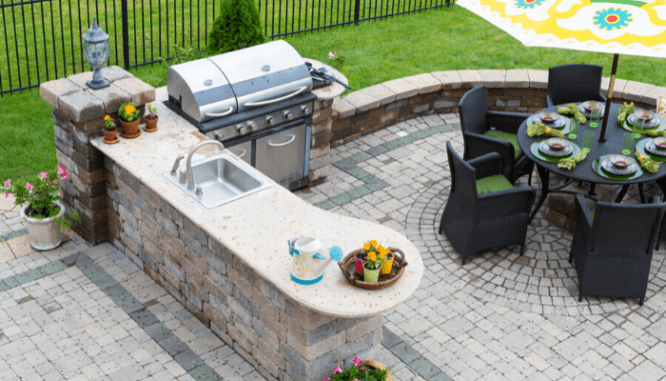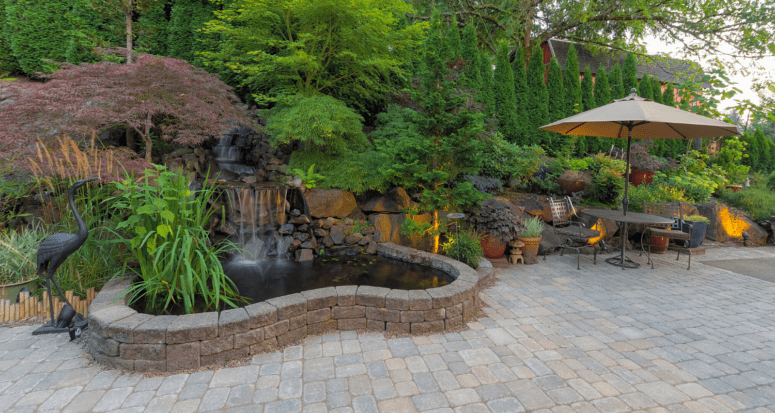Does Hardscaping Add Value to Your Home or Is Lots of Greenery Better?
- Published on
- 5 min read
-
 Valerie Kalfrin Contributing AuthorClose
Valerie Kalfrin Contributing AuthorClose Valerie Kalfrin Contributing Author
Valerie Kalfrin Contributing AuthorValerie Kalfrin is a multiple award-winning journalist, film and fiction fan, and creative storyteller with a knack for detailed, engaging stories.
Hardscaping goes far beyond the decomposed granite, gravel, and river rock you apply around plants to discourage weeds. The term “hardscaping” in fact encompasses everything that’s not a living part of your landscape, according to Jack Zunino, a landscape architect since 1980 and owner of JW Zunino Landscape Architecture in Las Vegas, Nevada.
Think pathways and pavers, patios and pergolas, fire pits and water features, play spaces and outdoor kitchens. Even a “Zen den,” a designated space designed for relaxing among nature, complete with a secluded divider and comfortable seating, falls into the hardscaping camp.
Although buyers can find hardscaping in virtually any price range, it’s particularly popular among high-end properties above $500,000, says Micah Pearson, a top-selling agent in the Salt Lake City, Utah, area. Before you rip up your grass to lay flagstone, let’s look at the best ways for hardscaping to add value to your home.

Trends in hardscaping: Sustainable design and functional space on the rise
Homeowners love outdoor space. According to the National Association of Landscape Professionals (NALP), 79% of Americans rank a lawn as the most important feature when renting or buying a home. Outdoor space is most popular among millennials (82%), compared to 81% of people in Generation X and 77% of baby boomers, the NALP says.
As for how people use it, consumers want sustainable design elements such as permeable paving (74%), as well as landscapes that are low-maintenance (80%), according to the American Society of Landscape Architects (ASLA).
While interior designers often mention “bringing the outdoors in,” surveys show that homeowners love the reverse: taking indoor features outside. Outdoor kitchens continue to top the list of popular kitchen features at 48%, according to the American Institute of Architects Home Design Trends Survey for the first quarter of 2020.
Allison Messner, cofounder of Yardzen, an online landscape design service that created more than 3% of all landscape designs nationwide in 2019, says in the company’s 2020 Outdoor Design Trends Forecast that many clients want to extend their home’s functional space by improving their yards and creating outdoor “rooms” that add square footage to a house economically. An open-air dining space was the most popular design feature that Yardzen clients requested.
Hardscaping vs. xeriscaping: What’s the difference?
Hardscaping reduces the maintenance of your landscape, much like xeriscaping, but the two terms aren’t interchangeable. While xeriscaping can incorporate hardscaping features such as gravel and pavers, it focuses on native plant materials and uses less water, such as through drip irrigation. Some estimates say that xeriscaping can reduce a home’s water use by up to 60%.
Although xeriscaping isn’t lush — the prefix “xeri” originates from a Greek word meaning “dry” — it’s not all about hard surfaces, either. Sometimes called “desert landscaping,” xeriscaping is prevalent in dry climates such as the Southwestern United States. The Southern Nevada Water Authority, for instance, offers a “Water Smart Landscapes” rebate program, paying $3 per square foot of grass replaced with desert landscaping up to the first 10,000 square feet.
In Utah, xeriscaping is more common at commercial properties, but it’s gaining traction among homeowners who don’t want to or can’t take care of the yard as much anymore, Pearson says.
Hardscaping vs. landscaping: Which has more value?
Industry experts say that hardscaping and landscaping provide the most value when they complement each other. According to one survey between the National Association of Realtors (NAR) and the NALP, projects that gave consumers the greatest desire to be at home include:
- A statement landscape (87%), including features such as space for yoga or activities such as croquet;
- A landscape upgrade (85%), such as installing a walkway of natural flagstone, adding stone planters and flowering shrubs, and applying mulch;
- A new patio (84%).
Combining hardscaping and traditional landscaping appeals to a broader segment of buyers because they can imagine more uses for the space, Pearson says. “I think it definitely adds value because it’s not trapping someone into what’s been created.”
Hardscape alone can look “stagnant,” notes Zunino. “Too much hardscape, I think, is unfriendly.” His backyard includes a bocce court but also grass for his grandchildren to play.
Although you don’t have to weed, water, and fertilize hardscaping, it still requires maintenance. Patios need sweeping, for instance. Decks need staining or resealing.
Plus, plants don’t just add color and beauty, Zunino adds. Deciduous trees, or those that shed leaves annually, offer shade in the spring and summer, block wind, and allow sunlight into a home in the winter, making it warmer. “Even in Las Vegas, the heater comes on in the winter,” he says.

5 hardscaping projects that add value to your home
The most attractive hardscaping projects evoke a “mini oasis concept,” Zunino says, such as a barbecue area where visitors can sit and relax. Although full outdoor kitchens complete with smokers, microwaves, and refrigerators are in vogue in Las Vegas, adding seating near the barbecue along with a sail or shade feature is an affordable redo.
At Pearson’s house, he has a covered area outside to barbecue year-round. “I’ve plumbed it so that my barbecue has constant natural gas, so that I’m not running out of propane,” he says.
Here are a few hardscaping projects that experts say are worth the cost:
1. Install an awning or canopy to make your outdoor space more enjoyable.
Adding such cover over a patio increases the chances you’ll use it, even in adverse weather, HomeAdvisor.com says. Prices vary depending on whether it’s retractable or motorized, but expect to pay about $1,300 to $3,800, including installation. (A rust-resistant steel-frame gazebo with mosquito netting, such as those Home Depot sells starting at about $200, may not add any value unless you tell your real estate agent it will sell with the house.)
2. Create architectural interest with a pergola.
Sturdier than an awning or canopy, this open-air frame with latticework roofing can offer shade to a patio as well as set off a cozy area for yoga or relaxation. (Yardzen says that 74% of its clients in 2019 requested such a space to chill out.) Building one costs about $2,150 to $5,816, depending on size, materials, and labor.
Accent it with lighting, or seating such as the Beachcroft Curved Corner Chair with Cushion from Ashley Furniture (about $630), the Puerta Grey 4-Piece Wicker Patio Conversation Set from Noble House (about $650), or Gold-Ticking Stripe Cabana Stools from The Inside ($49 each).
3. Build a deck for summer barbecuing.
A 14×18-foot wood deck, complete with decking, railing, stair treads, and sealer costs about $10,000 to install but recovers an estimated 80% of that at resale, according to a report from the NAR and NALP.
Pressure-treated decking is the most popular choice of deck materials nationwide because of cost, the NALP says. Cedar decking doesn’t transfer heat, so you can walk on it barefoot, even in summer. Vinyl decking gets hotter underfoot as temperatures rise and is more expensive, but it doesn’t absorb stains and requires less maintenance.
4. Create a lovely seating area with a patio.
An 18×16-foot concrete paver patio, dry set over compacted gravel, costs about $7,200 to install but recovers about $5,000 at resale, or 69% of the cost, the NAR and NALP say. The NALP calls a patio “the foundation for outdoor living” and recommends a number of materials besides concrete.
Gravel is inexpensive and informal, plus maintained easily with occasional raking. Baked clay bricks and interlocking pavers are lightweight and fit well in small spaces. Opt for limestone and sandstone in warm, dry climates and dense stone, such as bluestone and granite, in colder climates because it resists flaking and moss growth.
5. Invest in an outdoor kitchen.
Installing a inset grill, stainless-steel drawers, an ice chest, sink, and 60 square feet of concrete countertop costs about $14,000 but recovers about 71% of that at resale, the NAR and NALP say.
A less expensive option that still evokes outdoor gatherings is a top-rated gas, charcoal or kamado grill, such as the Dyna-Glo 4-Burner stainless-steel propane grill (about $300). Add seating such as the Coronado 3-piece Acacia Wood Patio Bistro Set from Christopher Knight Home (about $230), the Flash Furniture 5-piece Outdoor Patio Dining Set with glass table and aluminum chairs (about $168), or the Castelli 9-piece Sunbrella Dining Set (about $1,800).
3 hardscaping projects to avoid
One practical consideration about hardscaping: It’s harder to change. “You can easily move plants and put down pavers,” Zunino says.
So choose what you’ll enjoy while living in your home—not something you’re installing purely to attract buyers. Some people find certain features too specialized, such as:
- A fire feature: Fire pits and outdoor fireplaces recover an estimated 67% of the installation cost at resale. But your community or homeowner’s association might not allow them. “Some people absolutely love the idea of a fire pit area,” Pearson adds. “Others will feel it’s a wasted space because they’re not going to use it.”
- A water feature: Fountains, waterfalls, koi ponds, and even swimming pools add an “emotional connection to the property,” Pearson says, but they also tend to make buyers think of the upkeep.
- Bright colors and patterns: Although designers say a small porch or patio can appear larger if you paint a graphic black-and-white or faux tile pattern on the concrete, Pearson says that this could deter a buyer who can’t see past it. Decorate your hardscape with trending “earthy neutrals” such as subtle greens, hints of purple, and “greige” (gray plus beige).

How to make the most of your hardscaping projects
The more natural it looks, the more value your hardscaping adds to your home. “A big slab of concrete would be detrimental,” Zunino says, because it looks too “practical, like it’s your driveway.” To avoid that:
- Mix materials and textures: Select a variety of materials and finishes. Concrete is inexpensive but can be stamped, colored, or shaped like cobblestones or bricks. Travertine (irregular cuts of marble) ranges in color from cream to silver to yellow-orange. Flagstone comes in shades of tan, red, and buff in the Southwest and blue, green, and rust in the Northeast.
- Choose the right size: Hardscaping should fit the scale of your home and your yard. “If you make it too big, it feels uncomfortable,” Zunino says.
- Ensure it flows: Hardscaping needs to flow from one area of your yard to another, not seem like a mismatch. “I think sometimes, especially with outdoor projects, we tend to just use what’s available and not put as much thought into it,” Pearson says. “It’s very easy to tell when a homeowner jumps into a project without a plan.”
Whether you have hardscaping or you’re interested in adding some, envision the end result. Consult a landscape professional (some offer free consultations), as well as a real estate agent about what’s most worth your budget before listing.
“If you’re going to do an extensive amount of hardscape, it should be places that you’ll use,” Zunino says. “Just to do hardscape so you don’t have to maintain it makes absolutely no sense.”
Header Image Source: (JPL Designs / Shutterstock)
